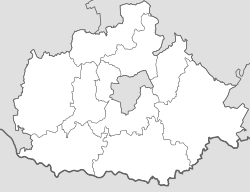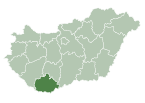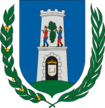|
Abaliget
Abaliget ([ˈɒbɒliɡɛt], German: Abaling) is a village (Hungarian: község) in central Baranya County, Pécs District, in southern Hungary. Until the end of World War II, the inhabitants' majority was Danube Swabian, also called locally as Stifolder, because their ancestors arrived in the 17th and 18th centuries from Fulda (district).[2] Most of the former German settlers were expelled to Allied-occupied Germany and Allied-occupied Austria in 1945–1948, pursuant to the Potsdam Agreement.[3] Only a few Germans of Hungary live there, the majority today are the descendants of Hungarians from the Czechoslovak–Hungarian population exchange. They got the houses of the former Danube Swabian inhabitants. It is located in the western Mecsek Mountains. The nearby Abaliget Cave and the area's lakes and hiking trails make it a popular tourist destination. Its population at the 2011 Census was 598.[4] GeographyThe village is located at 46° 8′ 39.08″ N, 18° 7′ 0.3″ E. Its area is 16.09 km2 (6.21 sq mi). It is part of the Southern Transdanubia statistical region, and administratively it falls under Baranya County and then Pécs District. It lies 12 km (7.5 mi) northwest of the city of Pécs[5] and is bordered by the villages of Husztót and Kovácsszénája to the north, Orfű to the east, Kővágószőlős and Kővágótöttös to the south, Hetvehely to the west, and Okorvölgy and Szentkatalin to the northwest. Abaliget is located in the western Mecsek Mountains, and much of its land lies within the Western Mecsek Landscape Protection District, managed by the Danube-Dráva National Park. The village is located on Middle Triassic limestone karst, which has formed the sinkholes, springs, tufa, and caves that are common features in the surrounding area.[6] NameThe name of the village originates from the Aba name, which is of Turkic origin and liget, which means "grove".[7] Demographics
2011 censusAs of the census of 2011, there were 598 residents, 248 households, and 159 families living in the village. The population density was 96 inhabitants per square mile (37/km2). There were 241 dwellings at an average density of 39 per square mile (15/km2). There were 248 households, of which 64.1% were one-family households, 0.0% were multi-family households, 33.1% were one-person households, and 2.8% were other non-family households. The average household size was 2.41. There were 159 families, of which 54.7% were couples living with children, 27.0% were couples living without children, 17.0% were single females with children, and 1.3% were single males with children. The average number of children was 1.26. The average family size was 3.08. The age breakdown of the village was 20.1% under the age of 20, 8.5% between ages 20 and 24, 27.1% aged 25 to 44, 31.6% aged 45 to 64, and 12.7% aged 65 and older. The gender ratio was 1.00 male to every female. In terms of educational attainment, 93.9% completed at least primary school, 44.1% completed at least secondary school with final examination, and 16.9% had a higher education degree.[4] Religious affiliation was 55.4% Roman Catholic, 4.0% Calvinist, 1.7% Greek Catholic, 0.3% Lutheran, 1.0% other religion, and 9.5% unaffiliated, with 28.1% declining to answer. The village had an ethnic minority Roma population of 14.4%. Other minority nationality affiliations of note were German (4.8%) and other, non-native to Hungary (3.8%), with small numbers of Poles, Croats, and Romanians totaling less than 1%. The vast majority declared themselves as Hungarian (83.9%), with 14.9% declining to answer.[note 1][8] Local governmentThe village is governed by a mayor with a four-person council. The local government of the village operates a joint council office with the nearby localities of Husztót, Kovácsszénája, Kővágótöttö, and Orfű. Abaliget maintains a branch office, but the seat of the joint council is in Orfű.[1][9] As of the election of 2019, the village also has a local minority self-government for its Roma community, with three elected representatives.[10] Mayors since 1990
Points of Interest
TransportationRailway
Road
Sister cities
Notes
References
|
|||||||||||||||||||||||||||||||||||||||||||||||||||||||||||||||||||||||||||||||||||||||||||||||||||||||||||||||||||||||||||






